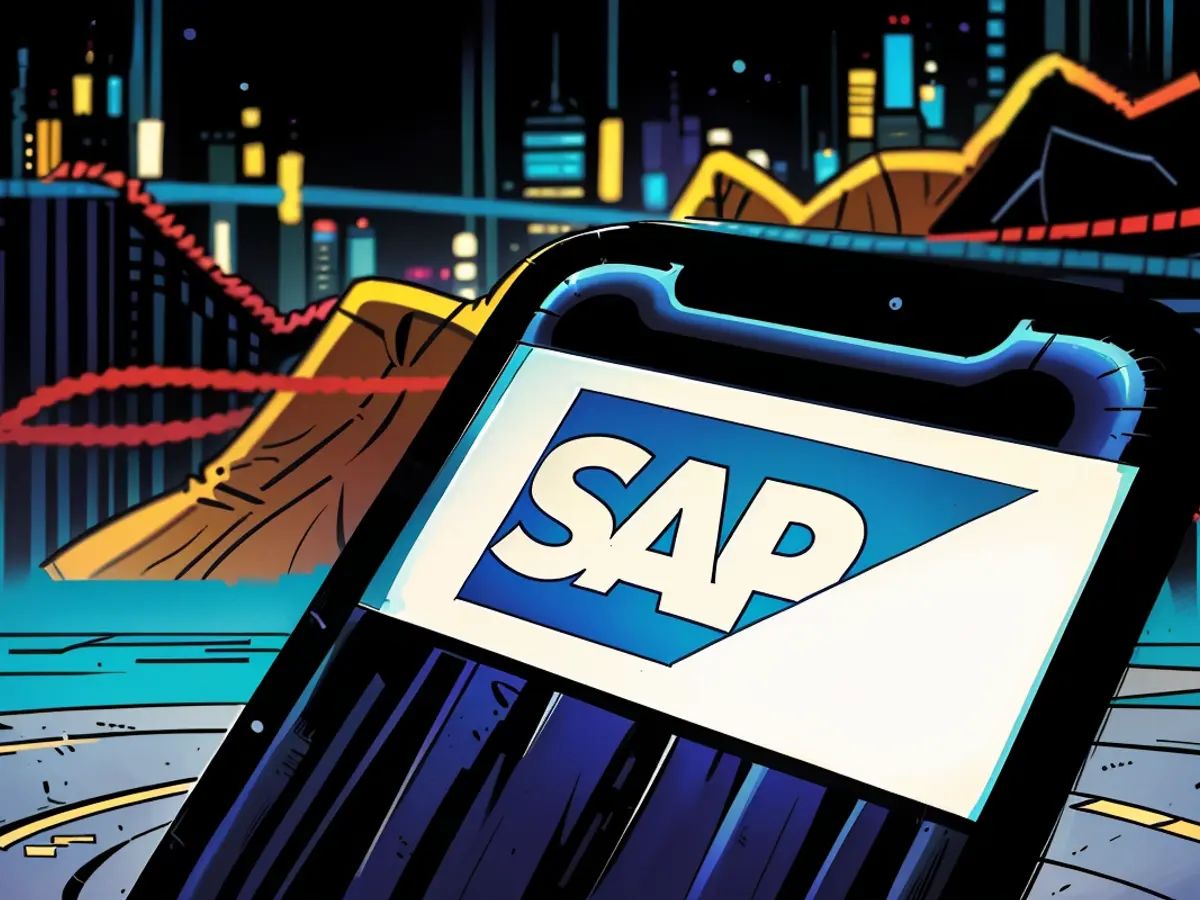The current position of the SAP in the stock market's major league?
SAP, the software titan hailing from Walldorf, Germany, has been the talk of the town recently. Despite the economic downturn, the tech giant has been making strides, leading to a steady rise in its stock price at the exchange for a solid year now. However, beneath the celebratory surface, a problem looms that was previously faced by a former heavyweight in the DAX.
Last Monday, SAP revealed impressive quarterly results after market close, far surpassing expectations in numerous regions, and setting higher targets for the full year. This performance drove the stock to an all-time high of over 222 euros on Tuesday, resulting in a 5% price surge. This growth boosted the DAX, offsetting its sluggish start to the week, before a dismal performance from Deutsche Bank brought the index back down to earth.
However, the celebration was short-lived. Due to the stock's surge, SAP exceeded the magical 15% weighting threshold in the German stock index. This limit, which was recently increased from 10%, has been responsible for pushing companies like Linde off the German stock exchange in the past. SAP, however, seems to be breaching this barrier sooner than anticipated.
Investors rejoice at ambitious annual targets
In the July to September quarter, SAP recorded a 9% increase in total revenue, reaching 8.47 billion euros. Operating profit before special items also saw a significant, unexpected jump of 27% year-on-year to 2.24 billion euros, while net profit was 13% higher at 1.44 billion euros. For the full year, SAP now anticipates a currency-adjusted increase in operating profit of 20% to 23%, up from the previous forecast of 17% to 21%.
The positive outlook can be attributed to the resilience of the lucrative software license business. SAP CEO Christian Klein is focusing on cloud software, which generates recurring revenues and enhances customer retention and profits. The cloud segment itself is meeting its targets, with revenue from cloud offerings increasing by a quarter and bookings for the next twelve months continuing to rise significantly.
This optimistic outlook has endeared investors, propelling the stock by 50% since the start of the year. SAP's current market capitalization stands at around 260 billion euros, making it more than 15% of the total market capitalization of all 40 DAX companies. Siemens trails in second place with around 10% of the market share.
Is SAP on the brink of becoming the second Linde?
With SAP now representing a 15% weighting in the DAX, it has triggered the so-called cap limit. This instrument implemented by the index operator Deutsche Boerse is designed to restrict a single company's influence in the index. The consequence is that index funds and ETFs, which mirror indices one-to-one, are obligated to sell shares of overweighted companies to avoid exceeding the limit themselves. For affected companies, this often results in a dampened stock price.
As the cap limit stood at 10% just a few months ago, it had resulted in a total of 38 cappings at four companies over the past decade. Linde surpassed the threshold multiple times, eventually deciding to delist from Germany. This was a massive blow for Deutsche Börse, which lost its most valuable company at the time. The index reform was meant to prevent a Linde incident 2.0.
However, even before the rule change, the potential for large stocks to attract even more investment was evident. Since the introduction of the 15% threshold, no capping has occurred, but SAP could now face this challenge more frequently, potentially putting the crucial German company in a challenging position. "We are not pleased with this limit," SAP CFO Dominik Asam told the Handelsblatt, indicating that discussions with Deutsche Börse and efforts to persuade US investors are underway.
This cap limit only applies to European indices, with a 15% limit in the French CAC 40 and Italian MIB 40 indices, and a 20% limit in the Swiss SMI index, which includes only 20 values. However, the UK's FTSE 100 index and the US's S&P 500 index do not restrict individual stock weightings, and no single stock has reached such a high weight yet.
According to a study by index provider S&P Dow Jones Indices, the proliferation of megacaps such as SAP in the German market is one of the reasons why actively managed funds underperform passively traded products like ETFs. This was a sentiment that the fund industry reiterated during the exchange's rule change debates, especially in the case of actively managed funds, which are limited to a 10% weight allocation to highly valued stocks to ensure adequate risk diversification.
SAP Prefers to Steer Clear of the Delicate Issue for Now. In the present Q4, the corporation is prioritizing its workforce reorganization initiative. The company is looking at shedding around 10,000 jobs. Many workers have the chance to apply for other roles within the company, but a substantial number will opt to depart. Starting from the new year, SAP aims to significantly lessen expenses through this restructuring, with projections pointing towards roughly 700 million euros in savings. However, it's anticipated that over 3 billion euros will be needed for the restructuring by year's end.
Source: Capital.de
SAP's current market capitalization is larger than Linde's at its peak, surpassing the 15% weighting threshold in the German stock index that once led Linde to delist.
In response to the potential cap limit issue, SAP CFO Dominik Asam expressed displeasure and indicated that negotiations with Deutsche Börse and efforts to persuade US investors are underway.








